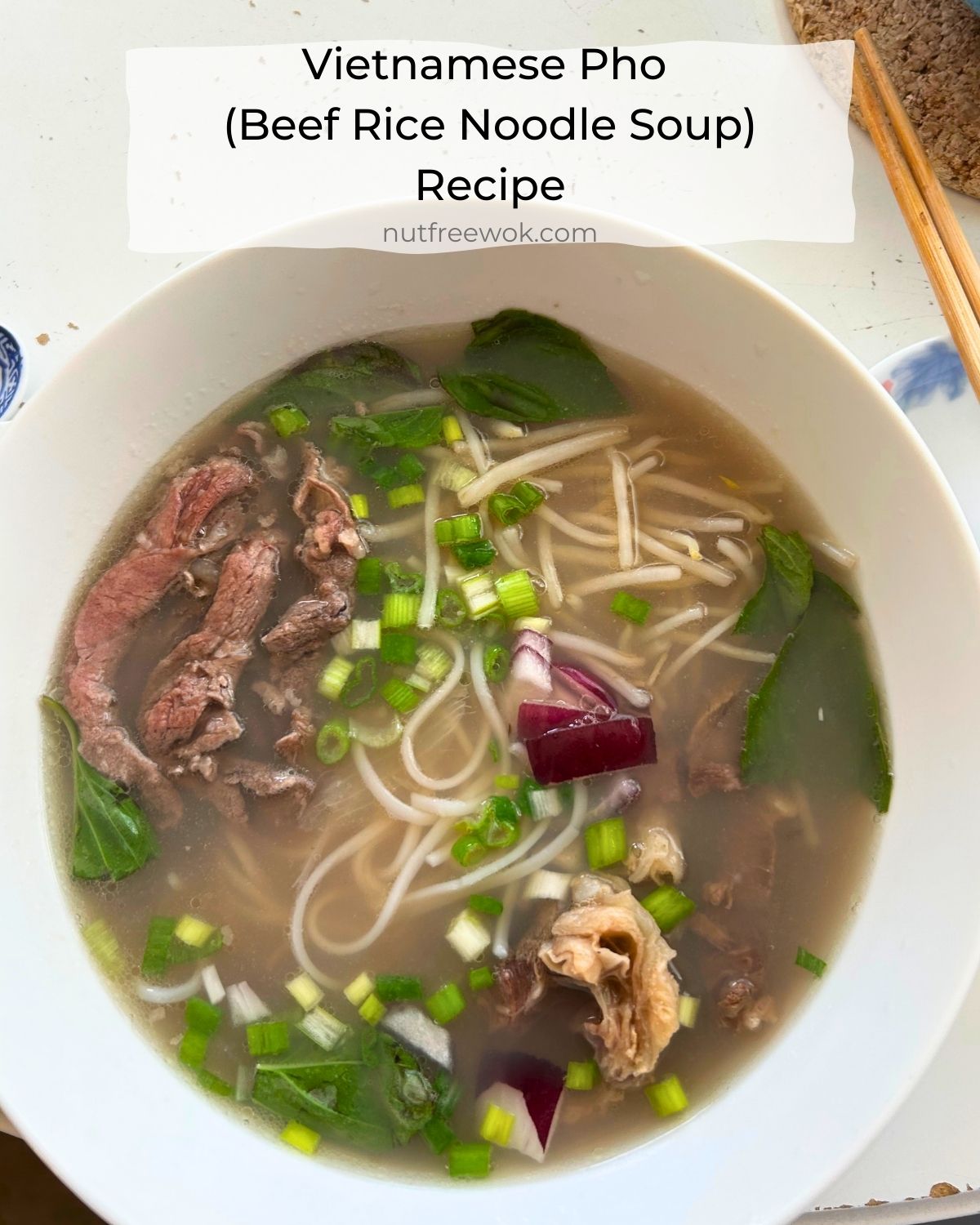
One of my favorite Vietnamese dishes is pho, a beef rice noodle soup. Rice noodles are topped with herbs, cooked beef and/or medium rare beef served with a spice-infused beef soup.
Disclaimer: Please check that all ingredients are suitable for your allergies and be sure to ask your medical care team regarding any allergy related questions (I do not share medical advice). As an Amazon Associate, I earn from qualifying purchases.
Jump to RecipePho is Allergy Friendly Comfort Food
Pho is so perfect when the weather is cold but I definitely crave it when I want some comfort food. This recipe is made from fresh ingredients and free of top 9 allergens as written, with the option to add hoisin sauce if not allergic. It took me many years to figure out the details and techniques through recipe development. I hope you enjoy it as much as my family and I do.
If you like pho, but don’t eat beef or prefer a lighter meal, I highly recommend that you take a look at my recipe for Pho Ga Recipe, Easy Vietnamese Chicken Pho Soup. It’s much faster to prepare and more economical.
Now that I know how to make pho, sometimes I still want to eat at Monster Pho, a nut-free Vietnamese restaurant. While some Vietnamese restaurants that aren’t nut-free are willing to accommodate nut allergies, homemade pho or Monster Pho are the best options for people who are highly sensitive to cross-contact or being around nuts.
Authentic Pho Recipe Inspiration
This recipe is my interpretation on how to make beef pho with a homemade beef broth, rice noodles, and delicious topping options with some adaptations of a family recipe from my friends, Brian and Kathy Hom.
I met Brian and Kathy many years ago when Brian organized food allergy walks in BJ’s memory. The Hom family are tireless advocates and selflessly share BJ’s tragic story to help save lives through awareness and legislation. They continue to make a difference through their Vitality Bowl restaurants and advocacy efforts.
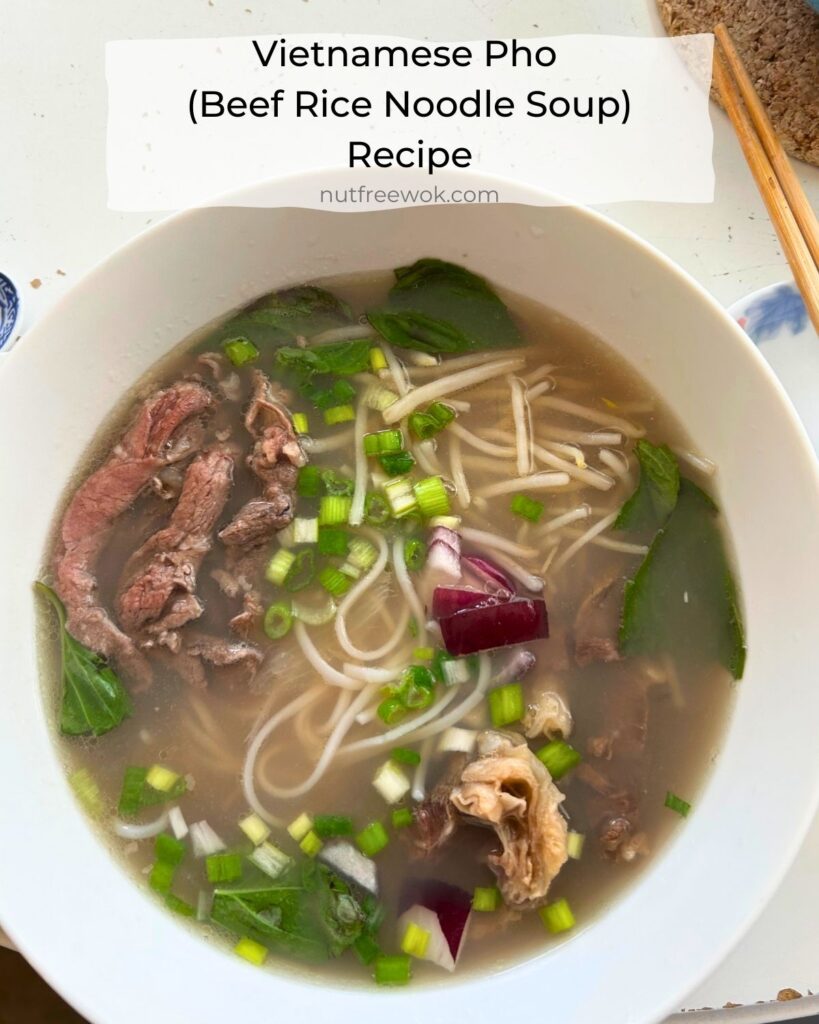
Buying Beef Bones for the Soup
Kathy’s recipe uses 4 pounds of beef bones (marrow and/or knuckles) to make the broth along with charred pieces of ginger and onion, spices, and seasoning and then topped with raw beef slices and beef meatballs and herbs.
I live nearly an hour away from an area with a lot of Vietnamese grocery stores which would stock the right kinds of beef bones for making pho. Since some of you might also not live near a Vietnamese grocery store, I decided to see what options are available at a conventional supermarket.
My local grocery store had a whole beef bone with knuckles and marrow and was very expensive. What’s worse was that the broth didn’t have much flavor, possibly because the bones did not have any meat on them at all.
But I wasn’t sure and asked a friend about how to improve the flavor of homemade beef pho. She told me that her family uses a powdered beef pho seasoning mix to add more flavor to the soup, which makes sense. They do taste great and I recently confirmed that Quoc Viet makes nut-free seasoning powder but I still wanted to figure out where to buy beef and beef bones for the soup.
Best Beef Bones for Pho
I want to make authentic pho soup that is full of protein, collagen, and becomes jelly-like when refrigerated. We love pho with bony cuts of beef with tasty meat on them such as oxtail and hind shank with bone. We really liked eating the yummy pieces of bone marrow from the hind shank and we like eating the pieces of cooked beef along with the flavorful broth.
After years of trying different variations, I settled on 2 pounds of bones with marrow and knuckles, 2 pounds of some combination of hind shank with bone marrow and/or oxtails, and approximately 1 pound of thinly sliced raw beef.
For the raw beef slices, I buy thinly sliced beef from Asian markets that is prepared for Chinese hot pot or Japanese shabu shabu. If that’s not available then Kathy recommends buying eye of round or filet mignon, freeze for 30-60 minutes, and thinly slice the beef against the grain.
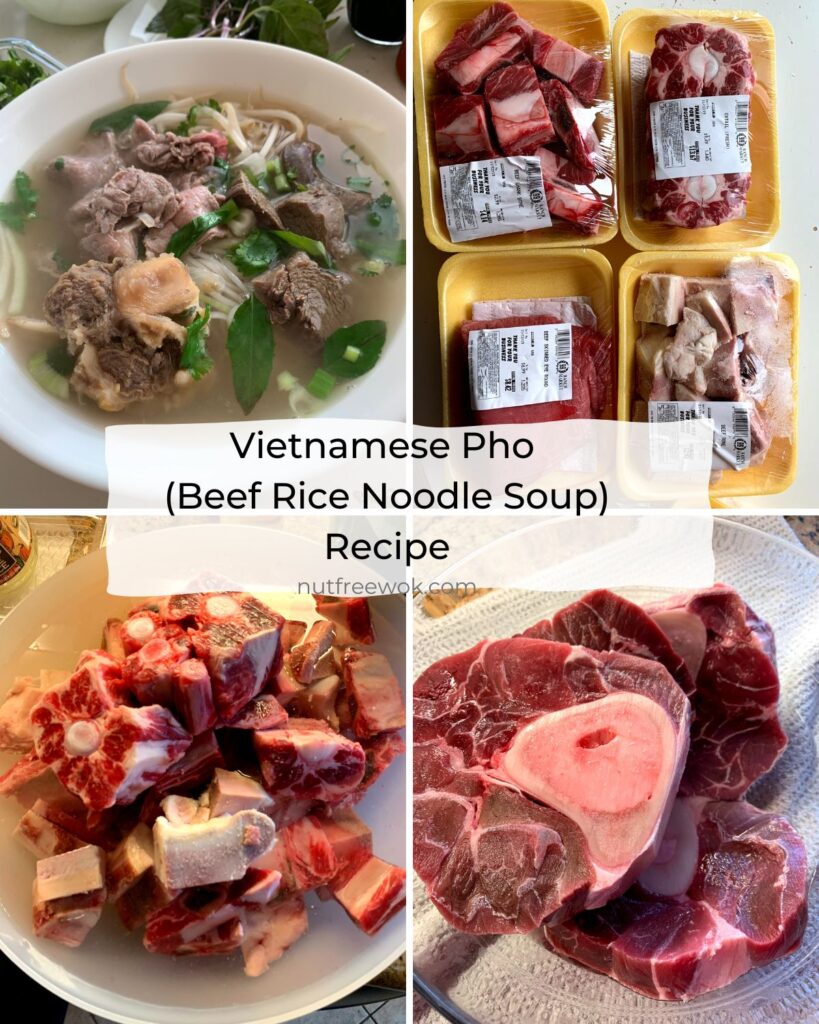
Beef Pho Preparation Steps
Pick the right sized pot
One of the biggest questions to ask yourself when making pho is how many people are you serving and do you want leftovers? Making the beef broth is probably the most labor intensive step and the size of your available pots is the most limiting factor.
My large stock pots range in size between 12- to 20-quarts so while I can make a large batch for our family of four, I don’t have adequate refrigerator space to store the leftovers. I would only double this recipe if I were cooking for 8 or more people.
This recipe will make enough pho for 4-6 servings in an 8 or 9-quart stock pot. If you have a 6-quart stock pot, you can still make 4 servings, but there is not a lot of room to make enough for seconds or leftovers, and you will need to adjust the cooking temperature so that the broth doesn’t bubble over while simmering.
Parboil and Clean the Beef Bones
Parboiling and cleaning the beef bones are essential steps to the recipe, do not skip them. Fill a large pot halfway with water and bring it to boil. While I wait for the water to boil, I soak the beef bones in warm water. This makes the parboiling step considerably less messy because the warm water will draw out a lot of blood.
Parboil the beef bones for 10 minutes and I recommend removing some of the foam and fat with a large spoon or ladle during the last few minutes of parboiling. Make a discard container either from an empty milk or juice carton or line a cup or large bowl with a plastic bag to discard the foam and extra fat. Avoid pouring the fat down your drain. Finally, remove the beef bones or strain the bones in a colander in your sink, rinse the bones clean, and clean your pot.
Simmer the Beef Broth and Prep the Other Ingredients
Add the cleaned bones back into the pot, fill the pot with water but allow room for the broth to simmer. Roast the ginger and onion, add them to the pot. While the broth simmers, prep your remaining ingredients and set aside. The total simmering time will take 3 hours and you add the toasted spices during the final 30 minutes.
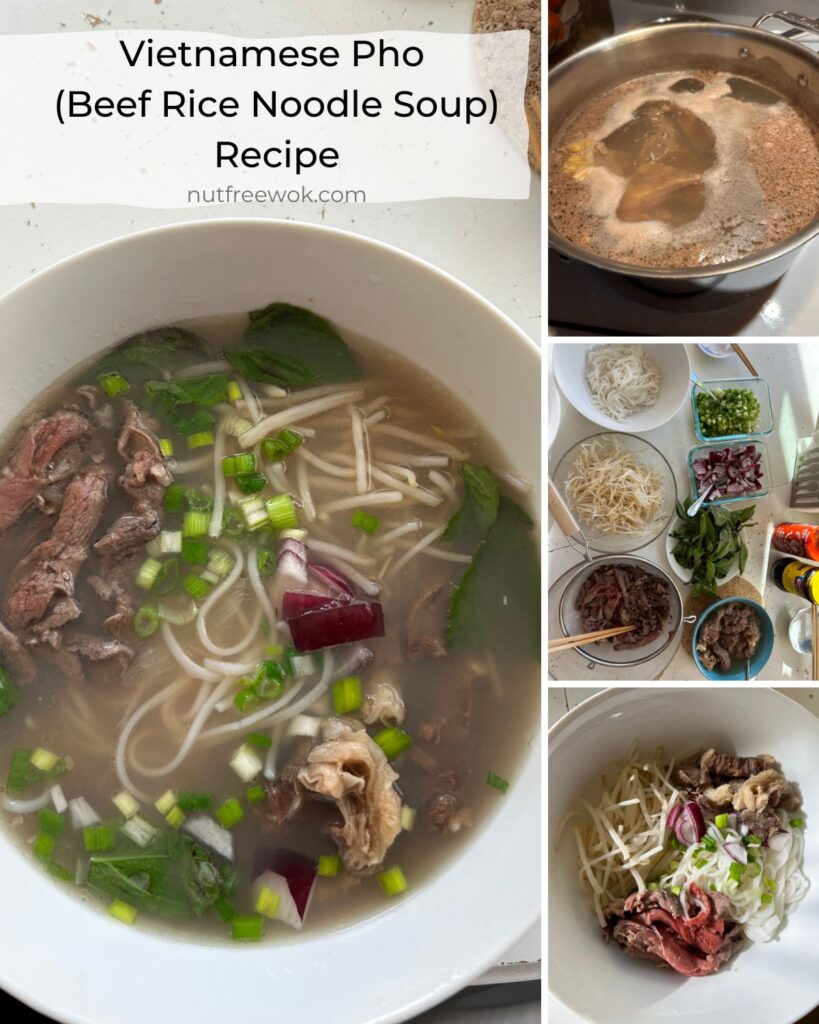
How to Serve and Eat Pho
Assemble Your Bowls of Pho
After 3 hours of simmering time, bring your broth to a rolling boil. While you are waiting for the broth to boil, remove the cooked hind shanks and/or oxtails in a large bowl and cover with some broth. Add a portion of the rice noodles to each bowl, top with chopped scallions, cilantro, and onions as desired. Arrange some pieces of cooked meat and thinly sliced pieces of raw beef, if using. You can skim and discard some of the fat from the broth, as desired. When the broth is bubbling vigorously, ladle the broth over the thinly sliced raw beef pieces to cook them.
Each Person Customizes Their Bowl
Once you serve the bowl of pho to your diners, it’s good etiquette to taste the broth first before customizing their bowls. It’s up to them on how they want to customize their bowls with pieces of Thai basil, mung bean sprouts, jalapeno slices, and squeezes of lime.
I tend to underseason my broth with 1.5 teaspoon of salt for about 4 quarts of broth and have fish sauce available at the table for those who can tolerate more sodium. If you have a higher tolerance for sodium, you could double the amount of salt (1 tablespoon) since many of the ingredients are plain, such as rice noodles, bean sprouts, and herbs.
I like mixing some sriracha and hoisin sauce, perhaps in a 1:2 ratio for dipping, others may prefer more or less of either sauces. Some people might add the sauces directly into their soup.
Leftovers
If you end up with any leftovers, I would cook the raw beef in the broth and bring the broth to a boil again before cooling to room temperature and storing in the refrigerator. 64-ounce mason jars are the best for refrigerating broth because they don’t take up a lot of shelf space. I love it when the leftover broth solidfies into a jelly-like consistency.
When I have time, I use the leftover bones in the pot to make a second round of beef broth. Discard the spices, add water to cover the bones, bring to a boil, and simmer for a few hours. I would use it to make something like beef barley mushroom soup (with a slight hint of the pho spices!).
I recently made pho and had a lot of leftover mung bean sprouts and herbs. I didn’t want them to go to waste and made them into a Mung Bean Sprouts and Herb Frittata for a quick and easy breakfast.
Allergy Aware Vietnamese Beef Pho
This recipe is free of peanuts, tree nuts, egg, milk, soy, shellfish, sesame, fish, and wheat as written. Homemade Vietnamese Beef Pho is a very allergy friendly dish to make.
I’ve opted to put the allergenic sauces as optional ingredients to serve at the table as desired. Some people like fish sauce in their pho and some don’t, so I recommend serving it on the side at the table instead of adding the fish sauce into the pot of soup.
If allergic to fish, skip the fish sauce which is made with anchovies. You could substitute with mushroom sauce, a vegan version of oyster sauce, for some umami. If not allergic to fish, I like fish sauce by Red Boat.
Hoisin sauce is usually made with soy, wheat, and sesame and is also an optional ingredient. I like Koon Chun (possible cross-contact with seafood, check with them) and Lee Kum Kee. There are also gluten-free hoisin sauce options, check What’s in Nut Free Wok’s Cupboard? Allergy Aware Ingredients.
Huy Fong’s sriracha is a top 8 free ingredient (and possibly sesame too, but I haven’t checked). If you are a huge sriracha fan, you might notice that the Huy Fong sriracha doesn’t look or taste exactly the same as before. The farm that grows the chili
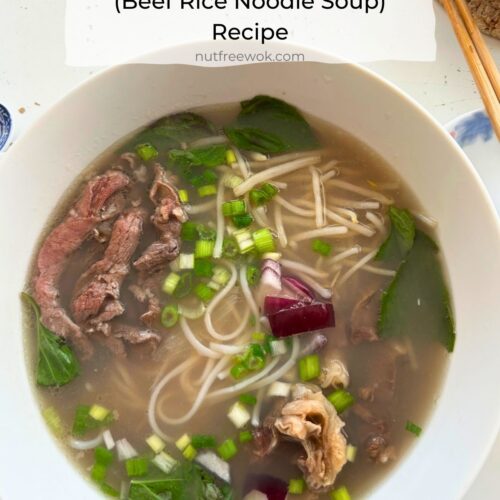
Vietnamese Beef Pho (Beef Rice Noodle Soup) Recipe
Equipment
- 1 large stock pot 8-9 quarts for the soup
- 1 medium pot 6-8 quarts for the rice noodles
- cheesecloth or spice ball
Ingredients
- 2 pounds beef bones shop for "beef bones for soup"
- 2 pounds beef shank and/or beef oxtail
- 1 large onion yellow or sweet
- 1 3-inch piece ginger
- 1 3-inch piece cinnamon stick
- 3 pieces star anise
- 1 teaspoon coriander seeds
- 1 teaspoon fennel seeds
- 1 piece cardamom (black) crack to open
- 3 pieces cloves
- 1 ounce rock sugar (ping pong ball size) or sugar (2 tablespoons)
- 1.5 teaspoon salt (up to 1-2 tablespoons, to taste)
Garnishes:
- ½ large onion chopped (red or yellow are milder)
- 1 bunch scallions chopped
- 1 cup cilantro chopped, optional
- 4 cups mung bean sprouts
- 6 springs Thai basil
- 1 medium lime cut into wedges (or lemon)
- 1 medium jalapeno cut into slices
- 1 pound thinly sliced beef ribeye, filet mignon, or eye of round
- 1 14-ounce package bahn pho (rice noodles) (size small or medium refers to width of the noodles) OR fresh noodles, if available.
Sauces at the table (optional): fish sauce, hoisin sauce, sriracha
Instructions
Broth
- Fill a large 8 to 9-quart stock pot halfway with water and bring to boil. While waiting for the water boil, fill a large bowl with warm water and soak the 2 pounds beef bones and 2 pounds beef shank (or oxtail). When the water boils, drain the water and add the bones to the pot of boiling water. Boil the bones for 10 minutes. During the last few minutes, use a ladle to scoop out the fat and blood particles and dispose of them in an old jar or milk container.
- After 10 minutes of parboiling the beef bones, place a large colander in your sink and strain the bones, rinse the bones to remove any blood, and clean the pot. Add the cleaned bones back into the pot and refill the pot with cold water. Don't overfill the pot, allow 1-2 inches for the soup to boil without bubbling over. You can add more water later.
- While waiting for the bones to boil, prepare 1 large onion and 1 3-inch piece ginger for roasting or charring. Peel off the outer layers of the onions, cut in half, and trim the root end of the onion slightly so that it stays intact. Split the ginger in half lengthwise. Place the pieces of onion and ginger in a frying pan and dry roast them until they are slightly charred. Option: If you have a gas stove, you can hold them with a pair of metal tongs and roast them over an open flame. Once the ginger and onion pieces are slightly charred, add them to the pot of water and bones.
- Preheat a clean dry frying pan on low-medium heat for a few minutes. While waiting use a nut-cracker to crack open 1 piece cardamom (black). Toast the spices, 1 3-inch piece cinnamon stick, 3 pieces star anise, 1 teaspoon coriander seeds, 1 teaspoon fennel seeds, 1 piece cardamom (black), and 3 pieces cloves in a clean dry frying pan until the spices fragrant, about 30 seconds to 1 minute in a warm pan. Transfer the spices in a mesh bag, wrap with a piece of cheese cloth and kitchen string, or place in a large spice ball. Set aside to add to the soup during the last hour of simmering.
- When the pot of water and bones come to a boil, lower the temperature between low and low-medium, to simmer the broth in the pot for 3 hours un-covered. Remove any foam, blood, or excessive fat with a spoon or fat skimmer.
Garnishes and noodles
- While the broth is simmering, prepare the garnishes. Chop ½ large onion and then soak in cold water for 10 minutes and drain, set aside. Chop 1 bunch scallions and 1 cup cilantro (if using), set aside. Arrange 4 cups mung bean sprouts, 6 springs Thai basil, lime wedges, and jalapeño slices on a serving plate, set aside.
- If you need to slice the raw beef (rib eye, filet mignon, or eye of round), place it in the freezer for 30-60 minutes before slicing. Pat the sliced beef with paper towels to blot some of the excess blood.
- If using dry rice stick noodles, cook the 1 14-ounce package bahn pho (rice noodles) according to the package instructions, until soft, and then drain in a colander and rinse. If using fresh rice noodles, add to a large pot of boiling water, stir, and immediately strain in a colander and rinse with cold water.
- After the 2 hours of simmering, add 1.5 teaspoon salt, 1 ounce rock sugar (ping pong ball size) , and the spice ball and continue to simmer the broth. After 3 hours, remove and discard the spices, transfer the cooked hind shank meat, oxtail pieces, and marrow pieces to a clean serving bowl and cover with 1-2 ladles of broth to keep the meat from drying out, remove the beef bones (set aside). Taste to see if the broth needs any more sugar or salt and add 1-2 teaspoons as desired. Increase the heat and bring the pho broth to a rolling boil.
Assemble
- While waiting for the pho to boil, divide the noodles into 6 servings and place them into large bowls (at least 3-4 cup capacity). Arrange a few pieces of cooked beef on the rice noodles, add some raw beef slices in a separate area, and sprinkle with some chopped onions, scallions, and cilantro. Add approximately 2 cups of boiling hot broth over the raw beef to cook it and then everyone can personalize their bowls with the remaining toppings.
Notes
Nutrition
Related Recipes
Beef pho is a great recipe to make for a large crowd. You can easily double this recipe if you have a 16-20 quart stock pot and allow extra time to bring your water to boil. You may also want to consider some related recipes:
- Vietnamese Chicken and Rice Vermicelli Salad Recipe
- Vietnamese Fresh Spring Rolls with Pork and Shrimp
- Vietnamese Dipping Sauce: Nuoc Cham
- Nut-Free Vietnamese Dip Recipe for Spring Rolls
- Garlic Noodles Recipe, Vietnamese Inspired
- Pho Ga Recipe, Easy Vietnamese Chicken Pho Soup
Thanks for reading, please help Nut Free Wok!
If you like this post or recipe, please be sure to give a 5 star rating, leave a comment, and share this post! Your support means a lot to me.
Subscribe to Nut Free Wok’s email subscription (be sure to respond to the confirmation email). You will be notified by email next time I publish another post or recipe and I won’t send you spam or share your email address with anyone.
Disclosure/Disclaimer:
I may mention the names of stores and/or brand names of products that I use because readers ask and I share products and sources which I use and think may be helpful to readers, all opinions are my own. Please note that manufacturing practices and ingredients can change at anytime without notice and readers are always responsible for assuring allergen safety before buying or consuming foods. NutFreeWok.com is a participant in the Amazon Services LLC Associates Program, an affiliate advertising program designed to provide a means for sites to earn advertising fees by advertising and linking to Amazon.com. Thank you for reading!
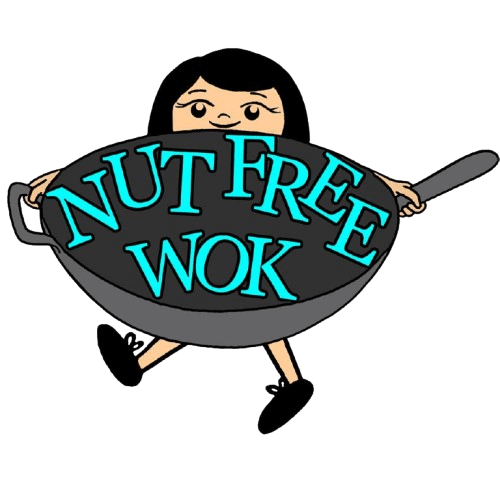
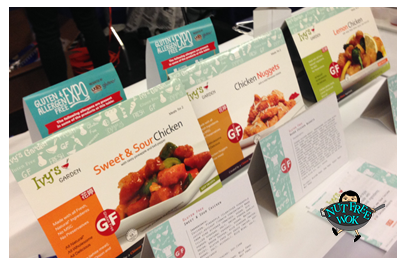

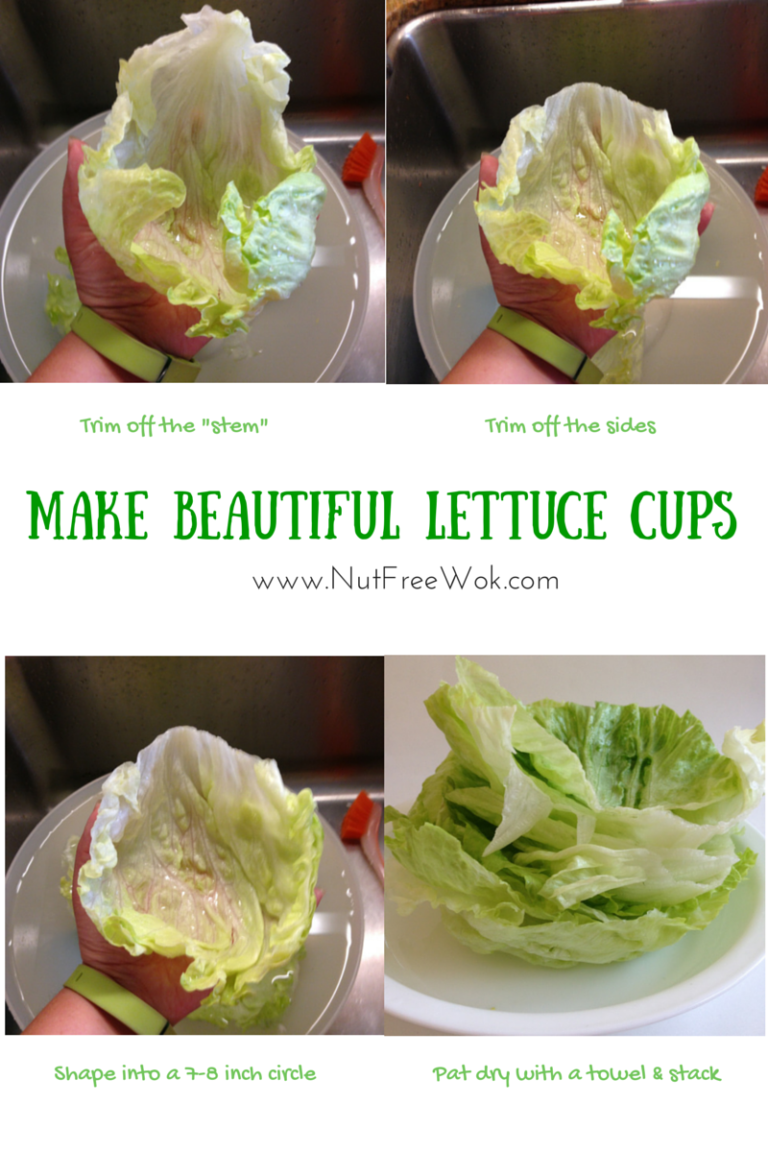
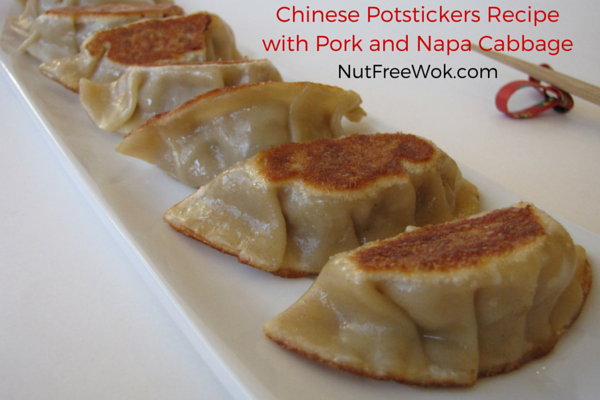
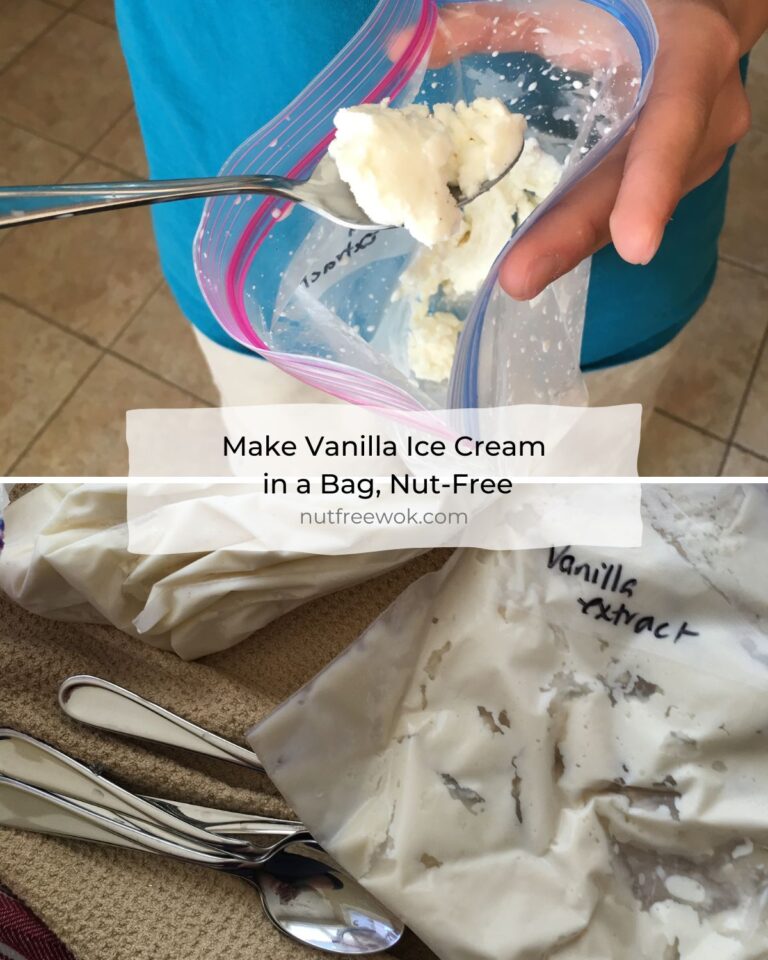
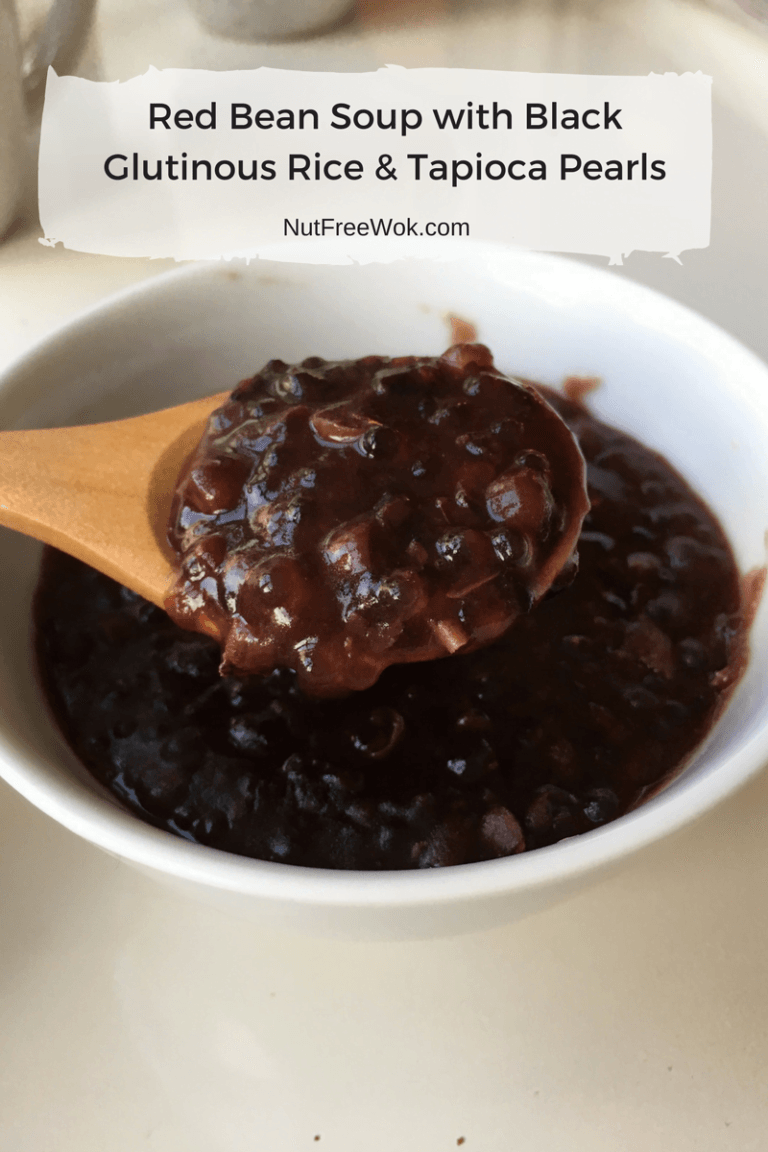
Hi! Thank you for sharing your recipes. I can’t wait to try them out. I was curious what brand of rice noodles and rice paper do you use that has been safe for you. We have similar allergies and would love to test it out. Thanks!
Hi Nili, you can check what’s in my cupboard to see what I use. Right off the top of my head, I usually buy the 3 Ladies brand (haven’t been able to confirm) or the Flying Horse brand from 99 Ranch, also distributed by Walong Market.